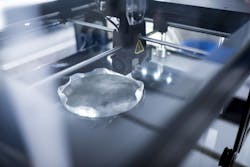These days, there’s no shortage of news about 3D printing and innovations in advanced manufacturing. From design enhancements to a hybrid approach to automated composite part production to changing business models—like, UPS adding 3D print services to its package delivery services. All of this indicates that the industry is on the fast track to move 3D printing from prototyping to production.
The latest announcement from SAP reinforces the role of 3D printing in the future of manufacturing. This week at Hannover Messe, the software company unveiled SAP Distributed Manufacturing, a new application that provides a cloud-based scalable process for manufacturers of all sizes. It is a collaborative business network that enables manufacturers to work with a variety of 3D printing companies, service and material providers and OEMs.
This offering is part of the recently launched SAP Leonardo portfolio for the Internet of Things (IoT) and works through integration with the SAP S/4HANA cloud that delivers business process automation as a service. SAP has partnered with 12 printing service providers, including UPS, which it has been working with for a year now.
For a fee, customers log on, upload a design, and have their approved vendors collaborate to set quality requirements. This offering may seem strange coming from SAP, an enterprise software company, but the company views 3D printing as a disruptive technology that impacts both manufacturing and the supply chain.
“We want to be an enabler for bringing this technology to our customers,” said Mike Lackey, SAP’s global vice president of solutions management for IoT and digital manufacturing.
Now, manufacturers are not inhibited by how many 3D printers they own because they have multiple service providers available to them that can accommodate many different materials. This opens the door to creativity and flexibility.
“Beyond the prototype it brings 3D printing into repair, spare parts and production,” Lackey said. “Customers want lot sizes of one. They want to buy products that are made for them and with 3D printing you don’t have to have things in inventory. You can make it on demand.”
Looking at UPS as an example, they have local stores with 3D printers, including a 3D printer factory in their distribution hub in Louisville, Ky. “They can print something at 4 a.m. and have it delivered to your door,” Lackey said.
As part of this week’s announcement, SAP also expanded its partnerships with HP and Jabil. HP plans to collaborate on eliminating friction in the process of evaluating and sourcing 3D print technology through integration with SAP’s enterprise systems and network of partners. And Jabil is co-innovating as both customer and partner with SAP to create end-to-end industrial digital manufacturing with real-time visibility to the machine level on the production floor. Combining Jabil’s manufacturing expertise with SAP Leonardo and manufacturing solutions, Jabil can create a digital twin to effectively manage the entire lifecycle of a part from design to production and recycling.
Among the first to work with SAP in auditing and certifying the processes of 3D printing service providers in the network is TÜV NORD, a Hannover-based technical services provider with operations in more than 70 countries, which plans to offer ISO 9001 certification adapted for distributed manufacturing.
“For customers it’s enormously important that the manufactured components should be of consistently high quality so that they can be safely and reliably used,” said Ulf Theike, general manager of TÜV NORD Systems. “To this end, demonstrably reliable processes and certification from trusted providers provide assurance that customers require.”
SAP has been conducting pilot tests with 45 customers for the last six months. As of this week, the SAP Distributed Manufacturing service has officially launched.
About the Author
Stephanie Neil
Editor-in-Chief, OEM Magazine

Leaders relevant to this article:
